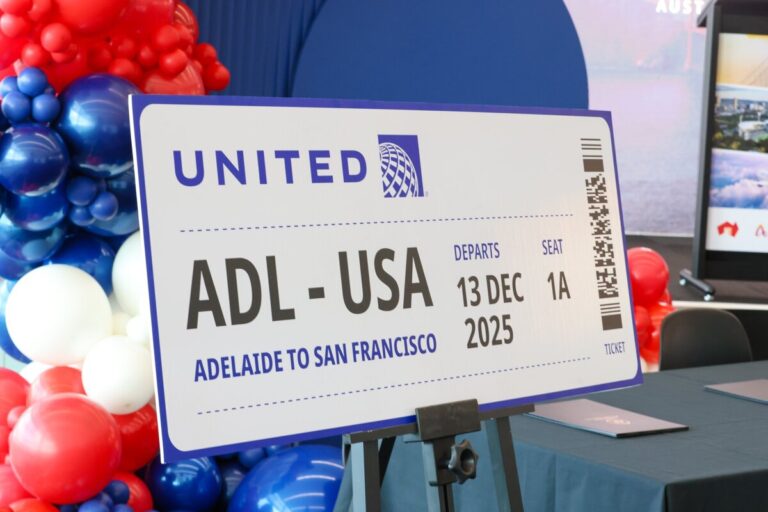
United Airlines is taking a significant step in expanding its global network by launching a new route to Adelaide, Australia, marking a bold move amid the uncertainties surrounding US border policies and international travel regulations. The direct flight from San Francisco to Adelaide, which began service in April 2025, is the airline’s first direct link between the United States and the South Australian city. The route will initially operate four times a week, with plans for expansion based on demand.
This expansion comes as United Airlines navigates a complex landscape of shifting travel regulations in the wake of evolving US border policies. While international travel has been steadily recovering since the peak of the COVID-19 pandemic, the US government’s policies regarding visa issuance, entry requirements, and other border restrictions continue to create uncertainties for travelers and airlines alike. Despite these challenges, United’s decision to launch the Adelaide route demonstrates the airline’s confidence in the resilience of the global aviation industry and the growing demand for travel to Australia.
United’s new Adelaide service is a direct response to the increasing demand for travel between the US and Australia. Over the past several years, there has been a steady uptick in the number of American tourists seeking to explore Australia’s diverse offerings, from the Great Barrier Reef to vibrant cities like Sydney and Melbourne. South Australia, in particular, has gained attention as a tourism hotspot, with its renowned wine regions, cultural festivals, and unique landscapes.
Adelaide, known for its relaxed pace of life, is now vying to be a key destination for international travelers. The addition of a direct flight will make it more accessible to the US market, and United Airlines is betting on this growing interest. By establishing a direct connection, the airline aims to provide convenience for travelers, cutting down on layovers and reducing overall flight times, which often deter potential tourists.
The launch of the Adelaide route is also a calculated move in the face of ongoing uncertainty surrounding US border policies. Despite the easing of many pandemic-related restrictions, there remains significant ambiguity in how the US government will handle international entry requirements in the future. The US Department of Homeland Security has been working on new visa processes, and travelers continue to face fluctuating regulations regarding vaccinations, testing, and other entry criteria.
The uncertainty surrounding these policies has led some airlines to be cautious with their international expansion plans. However, United Airlines has opted to push forward, viewing the Adelaide route as an investment in long-term growth rather than a short-term risk. The airline is betting that the demand for travel, particularly from US-based tourists eager to explore Australia, will outweigh the potential disruptions caused by changing border restrictions.
United Airlines’ decision to serve Adelaide also fits into the airline’s broader strategy of expanding its reach in the Asia-Pacific region. Australia remains a critical market for American carriers, with United already offering flights to Sydney, Melbourne, and Brisbane. The Adelaide route further strengthens United’s position in this lucrative region, providing more options for travelers connecting through San Francisco, which serves as a major West Coast hub for the airline.
The new service is expected to enhance Adelaide’s appeal as a key destination for international business as well. South Australia has been positioning itself as a growing center for industries such as defense, aerospace, and renewable energy. With Adelaide now connected directly to one of the US’s largest and most important cities, it is expected that this new air service will also foster closer business ties between the two regions, creating opportunities for collaboration and trade.
While United Airlines is optimistic about the new route, it will face significant competition from other carriers operating in the trans-Pacific market. Qantas Airways, the flag carrier of Australia, already offers direct flights to several US cities, including Los Angeles and Dallas/Fort Worth, and it will likely look to capitalize on its established market share. Moreover, other international airlines such as Air New Zealand and Singapore Airlines also provide options for passengers traveling between the US and Australia, adding further competition to United’s offerings.
Market dynamics will also play a critical role in the success of the Adelaide route. The airline will need to monitor demand carefully and adjust flight frequencies or pricing strategies as necessary to remain competitive. Additionally, the economic climate and consumer spending habits could influence the success of the route. If there is a downturn in global travel or a shift in consumer behavior, United may need to reassess its investment.
United Airlines’ new Adelaide route comes at a pivotal moment for the aviation industry. As the world continues to recover from the pandemic, airlines are looking to capitalize on the resurgence of travel, particularly long-haul international flights. United’s move into Adelaide is a part of this broader trend, demonstrating the airline’s commitment to strengthening its global network and meeting the needs of a post-pandemic world.
If successful, the Adelaide route could pave the way for similar expansions to other under-served international markets, particularly in regions where demand for long-haul travel is on the rise. The airline’s willingness to take a calculated risk in the face of US border uncertainties is a sign of confidence in the long-term growth of international travel, even in a world where border policies remain in flux.
In conclusion, United Airlines’ new Adelaide route represents more than just an expansion of its flight network it’s a bold bet on the future of international travel in a rapidly changing world. As the airline continues to navigate the challenges posed by US border policies, it will need to remain agile and responsive to the evolving needs of travelers. The success of this route could serve as a blueprint for future international expansions, signaling that even amid uncertainty, there are still opportunities for growth in the global aviation industry.

